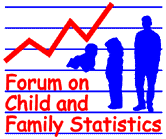
 |
|
 |


http://www.hhs.gov

Federal Interagency Forum on Child and Family Statistics
Federal Government Issues Key Report on Well-Being of Nation's Children
Embargoed until 9 a.m., Wednesday, July 2, 1997
Contact: Robin Peth-Pierce (301) 496-5133
More about
"America's Children"
America’s Children: Key National Indicators of Well-Being, 1997
View/download
PDF 1.4 MB
A new Federal report being issued today provides a composite picture of the well-being of the Nation's children.
"America's Children: Key National Indicators of Well-Being," presents, in a single document, 25 key indicators on critical aspects of children's lives, including their behavior and social environment, economic security, education, and health. The report, required by the recently issued Presidential Executive Order 13045, is the first in a planned annual series that will monitor the overall status of the Nation's children.
"This new report does more than provide a portrait of the well-being of our Nation's children," said Katherine Wallman, Chief Statistician at the Office of Management and Budget. "It challenges us to do better in collecting and reporting data on the Nation's most valuable resource: our children."
"For the first time, the Federal Government, paralleling to a degree the way it reports on the Nation's economic status, is taking a composite look at how our Nation's children are faring," said Duane Alexander, M.D., Director of the National Institute of Child Health and Human Development. "The report provides a valuable tool for tracking the condition of children and can help inform policy decisions that will affect them."
The indicators, such as child poverty, infant mortality, alcohol and substance abuse, and math and reading proficiency, were chosen because they measure critical aspects of children's lives and are collected rigorously and regularly by Federal agencies. The report also recommends the development of additional indicators, including more accurate measures of child poverty and homelessness, that would contribute to a fuller understanding of the overall condition of the Nation's children.
Issued by the Federal Interagency Forum on Child and Family Statistics, the report represents a significant collaborative effort among the various Federal agencies that report regularly on aspects of children's lives.
"We are pleased to be a partner in this first government-wide effort to develop a comprehensive set of national indicators that place education in a larger context," said Pascal D. Forgione, Jr., Ph.D., Commissioner, National Center for Education Statistics.
The report shows some positive trends in the overall health and education of the Nation's children. Fewer children are uncertain about where their next meal is coming from, more are being read to by their parents, and an increasing percent of children are being enrolled in early childhood education programs and graduating college. In addition, there has been an increase in childhood immunization rates and a decrease in infant and child mortality.
There are, however, several areas of children's lives that are not improving, including the use of illicit drugs and cigarette smoking among adolescents. In addition, more youths, particularly black males, have become victims of violent crime since 1980, although the rate decreased slightly in 1994.
In addition to the 25 regular indicators, this year's report includes a "special" indicator on child abuse, for which there is currently limited data available. The 1993 data indicate that 1.6 million children were victims of maltreatment, either abuse or neglect; children from families with annual incomes below $15,000 were 22 times more likely to experience abuse and neglect than were children from families with annual incomes above $30,000.
The Federal Interagency Forum on Child and Family Statistics was founded in 1994 and formally established by Executive Order 13045 to foster coordination and collaboration in the collection and reporting of Federal data on children and families. Statistical agencies within the departments of Agriculture, Commerce, Education, Health and Human Services, Housing and Urban Development, Justice, Labor, the National Science Foundation and the Office of Management and Budget make up the Federal forum.
The report will be released at a press conference at the National Press Club, 14th and F Street, NW on July 2, 1997, at 9:30 a.m. For more information, contact the National Institute of Child Health and Human Development (301) 496-5133. Copies of the full report can be obtained from the National Maternal and Child Health Bureau Clearinghouse (703) 356-1964, or via the Internet on the National Center for Health Statistics home page: http://www.cdc.gov/nchswww/default.htm, by July 2 at 9:30 a.m.
This page last reviewed
October 06, 2006
1-800-232-4636 |
